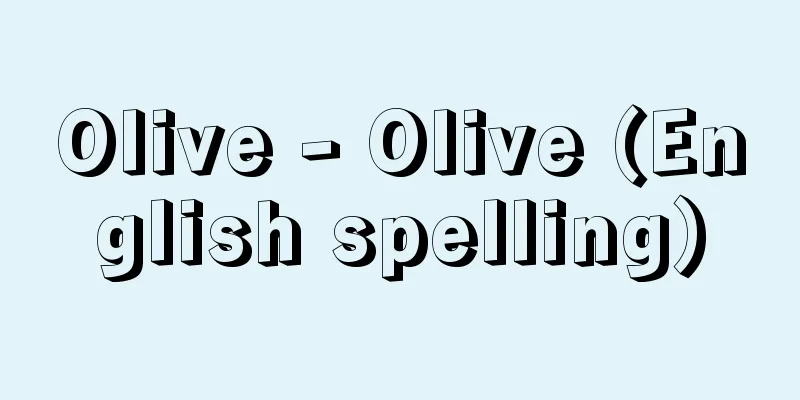Hairon - Hairon

|
This refers to theories on haikai and haiku. They include theories on the essence, expression, and rhetoric, but in early modern haiku theory, systematic theories are rare, and most are about formulas and etiquette as rules. Furthermore, the formation of haiku theory, which started from questioning the meaning of haikai itself in relation to its origin, renga, was heavily influenced by theories on renga and waka. First, in the early modern period, Teitoku, the founder of the Teimon school, wrote three books, "Gosan," "Aburakasu," and "Yodogawa," and established the formulas of haikai. He also defined that haikai is based on the vulgarity of waka and renga, as opposed to the elegance, and the humor of elegance, and that the essence of haiku lies in its willingness to use haigon (colloquialism and Chinese words) without shying away from them. The continuation of this position can be seen in works such as "Tamaki Shige" by Teitoku-mon's Koretare and "Shogakusho" by Tokugen. In response to this, the newly emerged Danrin school developed the position of its leader Soin, who viewed haiku as "dreamlike nonsense" (The Second Ship of the Oranda Maru), and his disciple Ronke Ichu advocated an allegorical theory based on the arguments of "Zhuangzi" in works such as "Haikai Mougyu," attempting to logically justify the unconcerned and free-spirited tone of Danrin haiku. It was during this period that a fierce debate broke out between the two schools. Then, in the Genroku period (1688-1704) of Shofu haiku theory, haiku theory showed advanced development and was explained from various angles, such as the theory of elegant sincerity, unchanging fashion, conformity to nature, high enlightenment and returning to the secular, sabi, shori, thinness, and lightness as aesthetic ideals, and scent, transition, resonance, and memory as a theory of correspondence, but the central proposition was the establishment of the idea of "correcting vulgar language" by examining and realizing "elegant sincerity". For Basho, the vulgarity of haiku is a phenomenon on the level of everyday life, and he found the essence of sincerity in the Basho style in "expressing nostalgia" in words, that is, in leading it to elegance on the level of poetry. In the Basho style, the humor of haiku is no longer seen as laughter due to a difference in ideas, but as humor due to the subtle exchange of images. Therefore, in expression, the "image" of a verse, that is, its figurative quality, was emphasized. We can get a glimpse of Basho's view of haiku and how his disciples understood it in works such as Kyorai's "Tabineron" and "Kyoraisho," Toho's "Sanzoshi," Shiko's "Kudzu no Matsubara," "Continued Five Essays," and "Ten Essays on Haiku," Kyoriku's "Haikai Mondo" and "Uda no Hoshi," and Kikaku's "Zodanshu." After that, from the Kyoho period (1716-36), the theory of haiku in the Shofu style was divided into two schools: the witty haiku of the Edo-za school led by Kikaku, and the Mino school of poetry led by Shiko, which respected the "form." However, during the An'ei and Tenmei periods (1772-89), the theory of haiku became active again amid the rise of the Shofu revival movement, and the theory of haiku that respected the early Shofu style began to gain momentum. Theories such as Bakusui's "Haiku Mougyu", Ranko's "Ari no Mama" which idealizes the late Sho style, and Shirao's "Kasari nashi" were presented, and Buson, who is connected to the former lineage, also expounded on his famous theory of leaving the world in the preface to his "Shundei Kushu", clarifying his position of leaving the worldly in his heart and aiming for lofty poetic sentiment. Furthermore, after the Bunka era, haiku theory often leaned towards historical commentary and lacked creativity, but there were still many notable works such as Seibi's "Zuisai Kaiwa" and Shiro's "Biwaen Zuihitsu". Furthermore, in the history of modern haiku, which was launched by the haiku reform movement of Masaoka Shiki, works such as Shiki's Dassai Shoku Haiwa and Haikai Daiyo, which advocated the theory of sketching, and Kawahigashi Hekigoto and others' theory of the new trend in haiku that does not require seasonal themes, Osuga Otsuji's theory of seasonal symbolism, and Takahama Kyoshi's theory of flower and bird poetry, had a major influence after World War II, and are still considered to be the second art of haiku by Kuwabara Takeo and Yamamoto Kenkichi's theory of pure haiku. [Minoru Horikiri] "Complete Collection of Japanese Classical Literature 51: Renga Essays, Nohgaku Essays, Haiku Essays" (1973, Shogakukan), edited by Riichi Kuriyama et al.; "Appreciation of Japanese Classical Literature 33: Haiku and Haiku Essays" (1977, Kadokawa Shoten), edited by Teiso Shiraishi and Ogata Toru. [References] |Source: Shogakukan Encyclopedia Nipponica About Encyclopedia Nipponica Information | Legend |
|
俳諧(はいかい)や俳句に関する論のこと。本質論、表現論、修辞論などを含むが、近世の俳論においては、体系的な論はまれで、ルールとしての式目作法的なものが大半を占める。また、その源流としての連歌(れんが)に対する俳諧自体の意味づけを問うところから出発した俳論の成立には、連歌論、歌論からの影響が大きい。まず近世初期、貞門派の開祖貞徳は『御傘(ごさん)』『油糟(あぶらかす)』『淀川(よどがわ)』の三部書などを著して俳諧の式目を整備するとともに、俳諧が和歌・連歌の雅に対する俗、優美に対する滑稽(こっけい)を生命とするものであることを規定し、また俳言(はいごん)(俗語や漢語)を嫌わず用いるところに俳諧の本質があるとした。貞徳門是誰(これたれ)の『玉くしげ』、徳元(とくげん)の『俳諧初学抄(しょがくしょう)』などにその立場の継承がうかがえる。これに対して新たに台頭した談林(だんりん)派では、総帥宗因(そういん)の、俳諧を「夢幻の戯言(ざれごと)」(阿蘭陀丸二番船(おらんだまるにばんせん))とみる立場を発展させて、門下の論客惟中(いちゅう)は『俳諧蒙求(もうぎゅう)』などに、『荘子(そうし)』の論に基づく寓言(ぐうげん)論を唱えて、談林俳諧の無心所着(むしんしょじゃく)にして自由奔放な吟調の論理的な正当化を図った。両派の間に激しい論争がおこったのもこの時期である。 ついで元禄(げんろく)期(1688~1704)の蕉風(しょうふう)俳論に至ると、俳論は高度な展開をみせ、俳諧本質論としての風雅の誠(まこと)、不易流行(ふえきりゅうこう)、造化随順(ぞうかずいじゅん)、高悟帰俗(こうごきぞく)、美的理念としてのさび・しをり・細み・軽み、付合(つけあい)論としての匂(にほ)ひ・うつり・ひびき・俤(おもかげ)など、さまざまな角度から説かれることになるが、その中心命題は「風雅の誠」を責め悟ることによって「俗語を正す」という理念を確立したところにあった。芭蕉(ばしょう)にとって俳諧の俗とは日常の次元の現象であり、これを詞(ことば)のうえで「懐しくいひとる」こと――すなわち詩の次元で雅に導いてゆくところに蕉風の誠の真髄をみいだしたのであった。俳諧の滑稽もまた蕉風にあっては、もはや観念の落差による笑いではなく、イメージの微妙な交流によるフモール(ユーモア)としてとらえられる。したがって表現においても、一句の「姿(景)」、つまり形象性が重視される方向に進んだ。去来の『旅寝論(たびねろん)』『去来抄』、土芳(とほう)の『三冊子(さんぞうし)』、支考の『葛(くず)の松原(まつばら)』『続五論(ぞくごろん)』『俳諧十論』、許六(きょりく)の『俳諧問答』『宇陀法師(うだのほうし)』、其角(きかく)の『雑談(ぞうだん)集』などに、それらの芭蕉の俳諧観およびそれに対する門人たちの理解の仕方をうかがうことができる。 その後、享保(きょうほう)期(1716~36)以降では、蕉風俳論は、其角ら江戸座流の「洒落(しゃれ)」の俳諧と、支考ら美濃(みの)派流の「姿」尊重の詩風との二分流を形成していったが、安永(あんえい)・天明(てんめい)(1772~89)の中興期に至ると、その蕉風復興運動の高揚のなかで、俳論はふたたび活発化し、初期蕉風を尊重する麦水(ばくすい)の『俳諧蒙求(もうぎゅう)』や後期蕉風を理想とする闌更(らんこう)の『有(あり)の儘(まま)』、白雄(しらお)の『加佐里那止(かざりなし)』の説などが提示され、前者の系列につながる蕪村(ぶそん)も『春泥(しゅんでい)句集』序文に名高い離俗論を説いて、胸中の俗気を去り、高邁(こうまい)な詩情を目ざす立場を明確にした。さらに化政期以降になると、俳論は多く考証的解説に傾いて創造性に乏しくなるが、それでも成美(せいび)の『随斎(ずいさい)諧話』、士朗(しろう)の『枇杷園(びわえん)随筆』など注目されるものも少なくない。 また、正岡子規(しき)の俳句革新運動によって幕開きされた近代俳句史の流れにおいても、写生説を提唱する子規の『獺祭書屋(だっさいしょおく)俳話』『俳諧大要』をはじめとして、河東碧梧桐(かわひがしへきごとう)ら新傾向俳句の季題無用論、大須賀乙字(おつじ)の季感象徴論、高浜虚子の花鳥諷詠(ふうえい)論へと展開し、第二次世界大戦後では、桑原武夫(たけお)のいわゆる俳句第二芸術論や、山本健吉の純粋俳句論などが、大きな影響を与えた。 [堀切 實] 『栗山理一他校注・訳『日本古典文学全集51 連歌論集・能楽論集・俳論集』(1973・小学館)』▽『白石悌三・尾形仂編『鑑賞日本古典文学33 俳句・俳論』(1977・角川書店)』 [参照項目] |出典 小学館 日本大百科全書(ニッポニカ)日本大百科全書(ニッポニカ)について 情報 | 凡例 |
>>: Pyrolite (English spelling)
Recommend
Mount Hotaka
It is a cone-shaped volcano with an elevation of ...
Ara (Hata) - Ara
…More than 60 species are known from the waters a...
IFJ - IFJ
《 International Federation of Journalists 》Interna...
Kansei-in Temple
...The Yamanashi National Medical University is l...
Gyrinidae
...After about two weeks, the adult Gyrinidae eme...
Euler cycle - Euler cycle
The period of the Earth's polar motion when as...
Porteña music - Porteña music (English spelling) música porteña [Spain]
"Porteña" is a feminine adjective meanin...
Piggyback ride - kataguruma
〘 noun 〙 (A word derived from the word "to pu...
Takasugi Shinsaku
He was a central figure in the anti-shogunate fac...
Address
...They sold menko, beigoma, glass marbles and ho...
Sea willow (Virgularia gustaviana)
A coelenterate (cnidaria) of the family Oligocalli...
Triosteum pinnatifidum
…[Mr. Makoto Fukuoka]. … *Some of the terminology...
Batavia
…It is located on the northwest coast of Java, at...
Abū Baka ibn Muammad ibn al Husayn al-Karkhi
An algebraist active in 11th-century Baghdad. Date...
Kara (Bulgaria) (English spelling) Kara
…the river that flows south from Bulgaria to Gree...









